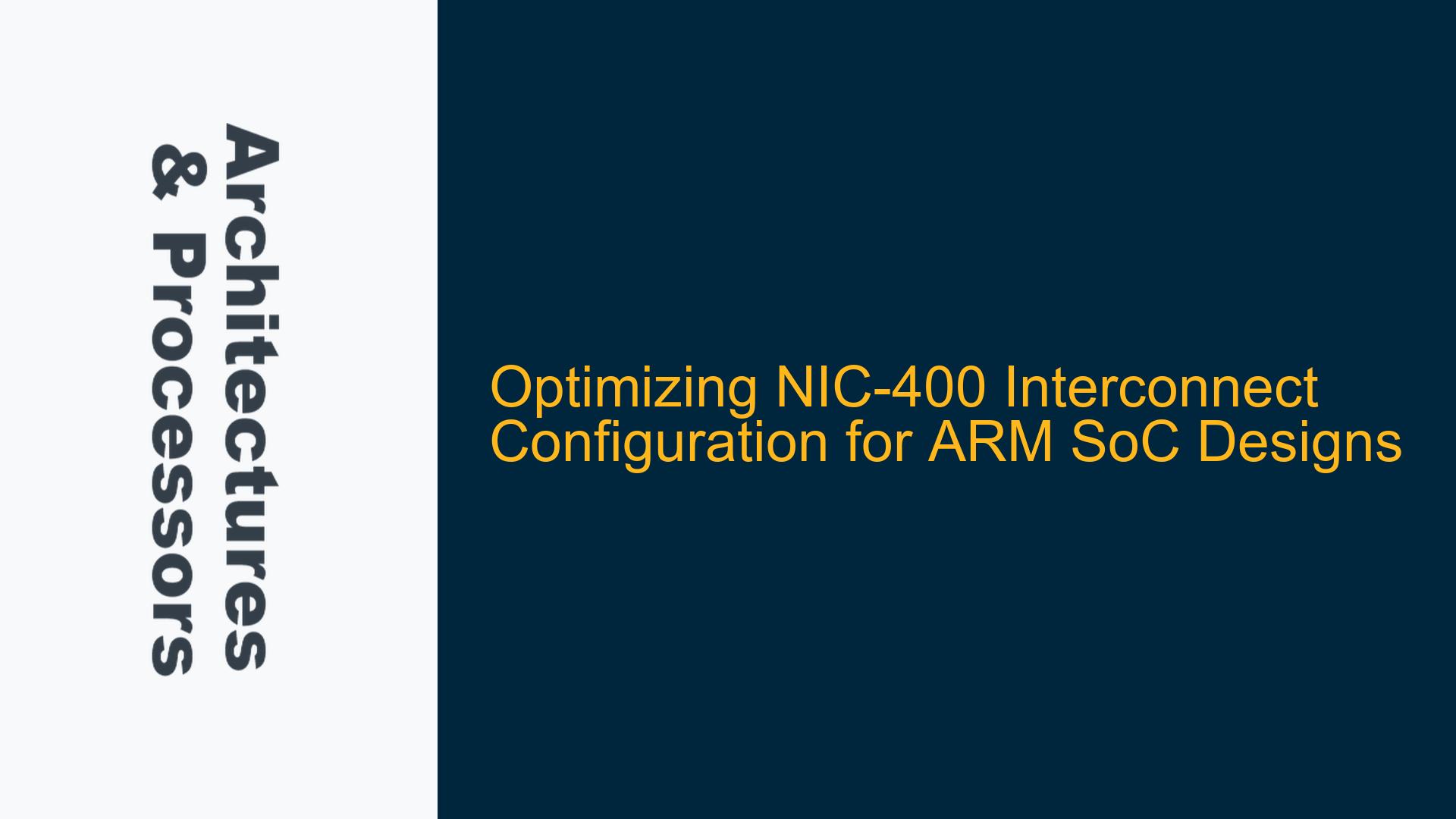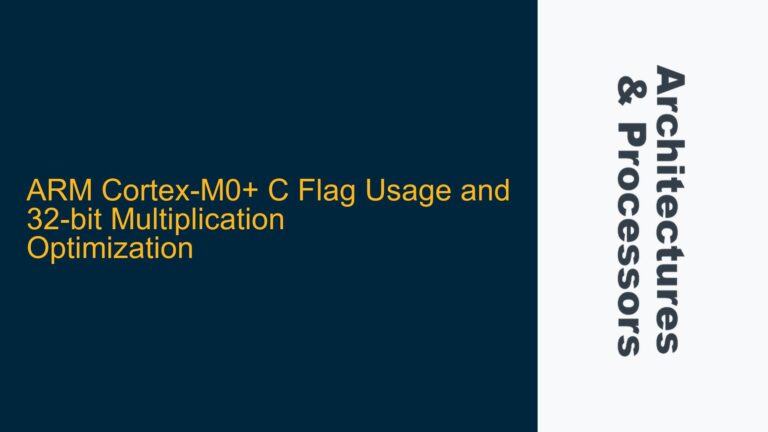ARM NIC-400 Interconnect Configuration Challenges in Multi-Master Multi-Slave Systems
In ARM-based SoC designs, the NIC-400 interconnect plays a critical role in managing communication between multiple masters and slaves. The NIC-400 is a highly configurable interconnect that supports AMBA protocols such as AXI, AHB, and APB, making it suitable for complex SoC architectures. However, when designing systems with a large number of masters and slaves, such as the scenario described with 16 masters (m0~m15) and 16 slaves (s0~s15), architects often face the challenge of deciding whether to use a single large NIC-400 or divide the interconnect into smaller NIC-400 instances. This decision impacts system performance, area, power consumption, and ease of verification.
The primary issue revolves around balancing the trade-offs between a monolithic NIC-400 configuration and a partitioned approach. In the given scenario, masters m0~m13 require access to slave s0, master m14 needs access to slaves s0 and s1, and master m15 requires access to all 16 slaves. This heterogeneous access pattern complicates the interconnect design, as it must efficiently handle both localized and global traffic without introducing bottlenecks or excessive latency.
A monolithic 16×16 NIC-400 configuration simplifies the interconnect structure by providing a single point of control and management. However, it may lead to unnecessary complexity in routing and arbitration logic, especially for masters with limited access requirements. On the other hand, partitioning the NIC-400 into smaller instances, such as a 14×1 NIC-400 for m0~m13 and a 3×16 NIC-400 for the remaining masters, can optimize resource utilization but introduces additional challenges in managing cross-interconnect communication and synchronization.
Clock Domain Synchronization and Interconnect Grouping Constraints
One of the key factors influencing the decision to partition the NIC-400 is the clock domain configuration. In the described system, all masters and slaves operate in synchronous clock domains, with relationships such as 1:1, n:1, or 1:n. While this simplifies clock domain crossing (CDC) issues, it does not eliminate the need for careful consideration of clock grouping within the NIC-400.
The NIC-400 supports grouping of interfaces based on characteristics such as data width, clock domain, and protocol. Proper grouping is essential to minimize latency and ensure efficient arbitration. For example, masters m0~m13, which primarily access slave s0, can be grouped together to reduce arbitration overhead. Similarly, masters m14 and m15, which have broader access requirements, may benefit from being grouped separately to avoid contention with the more localized traffic.
However, improper grouping or excessive partitioning can lead to suboptimal performance. For instance, if the 14×1 NIC-400 for m0~m13 is not configured correctly, it may introduce additional latency for masters that occasionally need to access other slaves. Similarly, the 3×16 NIC-400 must be designed to handle the diverse access patterns of m14 and m15 without becoming a bottleneck.
Another consideration is the impact of partitioning on system-level verification. A monolithic NIC-400 simplifies verification by providing a single point of control, whereas partitioned NIC-400 instances require additional effort to verify cross-interconnect communication and ensure compliance with the AMBA protocol.
Implementing an Optimal NIC-400 Configuration for Performance and Scalability
To address the challenges outlined above, the following steps can be taken to implement an optimal NIC-400 configuration:
-
Evaluate Traffic Patterns and Access Requirements: Begin by analyzing the access patterns of all masters and slaves. Identify which masters have localized access requirements (e.g., m0~m13 accessing s0) and which have broader requirements (e.g., m15 accessing all slaves). This analysis will guide the decision on whether to partition the NIC-400.
-
Leverage NIC-400 Grouping Features: Use the grouping capabilities of the NIC-400 to optimize arbitration and routing. Group masters with similar access patterns and clock domains together to minimize latency and contention. For example, group m0~m13 into a single group targeting s0, and create separate groups for m14 and m15 based on their access requirements.
-
Balance Partitioning and Monolithic Configurations: Consider a hybrid approach that combines the benefits of both partitioning and a monolithic configuration. For instance, use a 14×1 NIC-400 for m0~m13 to handle localized traffic efficiently, and integrate this with a larger NIC-400 instance for m14 and m15. This approach reduces the complexity of the larger NIC-400 while maintaining efficient communication between partitions.
-
Optimize Arbitration and Routing Logic: Configure the NIC-400 arbitration logic to prioritize critical traffic and minimize latency. Use weighted arbitration schemes to ensure fair access for all masters while prioritizing high-bandwidth or time-sensitive transactions.
-
Verify Cross-Interconnect Communication: If partitioning is used, thoroughly verify cross-interconnect communication to ensure compliance with the AMBA protocol. Use SystemVerilog and UVM-based testbenches to simulate traffic patterns and identify potential bottlenecks or protocol violations.
-
Consider Area and Power Implications: Evaluate the area and power consumption of different configurations. While partitioning may reduce resource utilization in some cases, it can also increase overall area and power due to additional interconnect logic. Use synthesis tools to estimate the impact of different configurations on area and power.
-
Use Socrates GUI for Configuration: Leverage the Socrates GUI provided by ARM to configure the NIC-400. The GUI simplifies the process of defining groups, setting arbitration priorities, and generating the interconnect structure. It also provides visual feedback on the configuration, making it easier to identify potential issues.
By following these steps, designers can implement an optimal NIC-400 configuration that balances performance, scalability, and resource utilization. The key is to carefully analyze the system requirements, leverage the features of the NIC-400, and validate the design through rigorous verification.
Detailed Analysis of NIC-400 Configuration Options
To further illustrate the decision-making process, let’s compare the two primary configuration options: a monolithic 16×16 NIC-400 and a partitioned approach using a 14×1 NIC-400 and a 3×16 NIC-400.
Monolithic 16×16 NIC-400 Configuration
| Aspect | Advantages | Disadvantages |
|---|---|---|
| Complexity | Single point of control and management simplifies design and verification. | Increased complexity in routing and arbitration logic due to heterogeneous traffic. |
| Performance | Centralized arbitration can optimize resource utilization for global traffic. | Potential for higher latency and contention due to a large number of masters and slaves. |
| Area and Power | May result in higher area and power consumption due to a larger interconnect. | |
| Scalability | Easier to scale for future additions of masters or slaves. | |
| Verification | Simplified verification with a single interconnect instance. |
Partitioned 14×1 and 3×16 NIC-400 Configuration
| Aspect | Advantages | Disadvantages |
|---|---|---|
| Complexity | Reduces complexity by isolating localized traffic (m0~m13) from global traffic. | Introduces additional complexity in managing cross-interconnect communication. |
| Performance | Optimizes performance for localized traffic by reducing arbitration overhead. | Potential for increased latency in cross-interconnect communication. |
| Area and Power | May reduce area and power consumption by optimizing resource utilization. | Additional interconnect logic may offset area and power savings. |
| Scalability | Less scalable for future additions, as partitions may need to be reconfigured. | |
| Verification | Requires additional effort to verify cross-interconnect communication. |
Hybrid Configuration
A hybrid configuration combines the benefits of both approaches. For example, a 14×1 NIC-400 can be used for m0~m13, while a larger NIC-400 instance handles m14 and m15. This approach reduces the complexity of the larger NIC-400 while maintaining efficient communication between partitions.
| Aspect | Advantages | Disadvantages |
|---|---|---|
| Complexity | Balances complexity by isolating localized traffic while managing global traffic. | Requires careful design to ensure seamless communication between partitions. |
| Performance | Optimizes performance for both localized and global traffic. | Slightly increased complexity in arbitration logic. |
| Area and Power | Potential for reduced area and power consumption compared to a monolithic design. | |
| Scalability | More scalable than a fully partitioned design, but less than a monolithic one. | |
| Verification | Requires verification of both localized and cross-interconnect communication. |
Conclusion
The decision to use a monolithic NIC-400 or a partitioned approach depends on the specific requirements of the system, including traffic patterns, performance goals, area and power constraints, and verification complexity. By carefully analyzing these factors and leveraging the features of the NIC-400, designers can implement an optimal interconnect configuration that meets the needs of their ARM-based SoC design.






